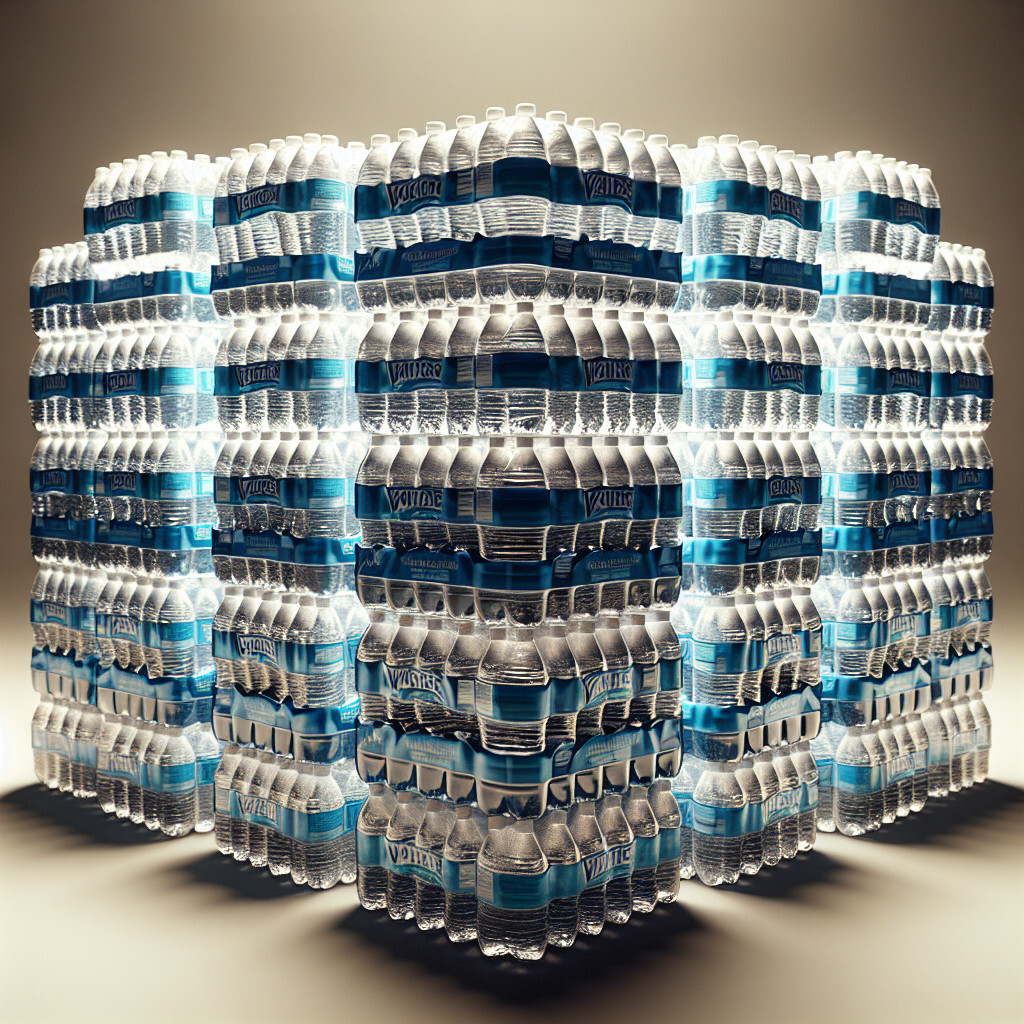-
Table of Contents
“Hydrate Uninterrupted: 84 Cases of Pure, Refreshing Bottled Water.”
Introduction

Bottled water 84 cases refer to a bulk purchase of bottled water, typically used for large events, disaster relief, or long-term storage. Each case usually contains 24 bottles, meaning that 84 cases would provide 2,016 individual bottles of water. This water is often purified or spring water, sealed for freshness and safety, and is a convenient, portable option for hydration.
Understanding the Environmental Impact of 84 Cases of Bottled Water
Bottled water is a common sight in our daily lives, from the gym to the office, from the school to the supermarket. It’s convenient, it’s clean, and it’s readily available. But have you ever stopped to consider the environmental impact of your bottled water consumption? Let’s take a closer look at the environmental footprint of 84 cases of bottled water, a quantity that an average American family might consume in a year.
Firstly, it’s important to understand the manufacturing process of bottled water. The production of plastic bottles requires a significant amount of energy and resources. It’s estimated that the energy required to make the plastic for one bottle is equivalent to filling that bottle a quarter of the way with oil. Multiply that by the 2,016 bottles in 84 cases, and you begin to grasp the enormity of the energy consumption involved.
Moreover, the production process also involves a considerable amount of water. It takes approximately three times the volume of water to produce one bottle than it does to fill it. This means that for 84 cases of bottled water, around 6,048 liters of water are used in the production process alone. This is a significant waste of a precious resource, especially considering the increasing scarcity of clean, fresh water in many parts of the world.
The environmental impact of bottled water doesn’t stop at production. Once the water is consumed, the plastic bottles often end up in landfills, where they can take up to 1,000 years to decompose. Even when recycled, the process requires additional energy and resources. Furthermore, not all bottles make it to the recycling bin. Many end up in our oceans, contributing to the growing problem of plastic pollution and posing a threat to marine life.
Transportation is another factor to consider. Bottled water is often transported long distances, sometimes across continents, before it reaches the consumer. This involves burning fossil fuels, contributing to air pollution and climate change. The carbon footprint of transporting 84 cases of bottled water can be substantial, particularly if the water is imported from another country.
Lastly, the extraction of water for bottling can have detrimental effects on local communities and ecosystems. In many cases, water is drawn from underground aquifers faster than it can be naturally replenished, leading to water shortages and damage to local ecosystems. This is particularly concerning in areas where water is already scarce.
In conclusion, the environmental impact of 84 cases of bottled water is significant, encompassing energy consumption, water waste, plastic pollution, carbon emissions, and potential harm to local communities and ecosystems. While bottled water may be convenient, it’s clear that this convenience comes at a high environmental cost. As consumers, it’s important for us to be aware of these impacts and consider more sustainable alternatives, such as using refillable water bottles and supporting initiatives that promote clean tap water. By making informed choices, we can help to reduce the environmental footprint of our water consumption.
The Health Implications of Consuming 84 Cases of Bottled Water
Bottled water is a common sight in many households, offices, and public spaces. It is often seen as a convenient and healthy alternative to tap water. However, the consumption of bottled water, particularly in large quantities such as 84 cases, can have significant health implications.
Firstly, it is important to understand that not all bottled water is created equal. Some brands source their water directly from springs or artesian wells, while others simply treat and bottle tap water. The quality and safety of bottled water can therefore vary greatly depending on the source and the treatment process. In some cases, bottled water has been found to contain harmful contaminants such as bacteria, arsenic, and synthetic organic chemicals. Consuming such water over a prolonged period can lead to serious health issues including gastrointestinal illnesses, reproductive problems, and neurological disorders.
Moreover, the plastic bottles in which the water is packaged can also pose health risks. Most bottled water is packaged in plastic bottles made from polyethylene terephthalate (PET), which can leach chemicals into the water, especially when exposed to heat or stored for a long time. These chemicals include antimony, a heavy metal that can cause vomiting, diarrhea and stomach ulcers, and bisphenol A (BPA), a synthetic compound that has been linked to a range of health problems including heart disease, diabetes, and reproductive issues.
In addition to the potential health risks associated with the water itself and the plastic bottles, consuming large quantities of bottled water can also contribute to overhydration or water intoxication. This is a serious condition that occurs when you drink so much water that your kidneys can’t excrete the excess water. The excess water can dilute the electrolytes in your blood, especially sodium, leading to low blood sodium levels, a condition known as hyponatremia. Symptoms of hyponatremia can range from mild to life-threatening, and can include nausea, headache, confusion, seizures, and in severe cases, coma and death.
Furthermore, the environmental impact of consuming bottled water on such a large scale cannot be overlooked. The production and disposal of plastic bottles contribute significantly to pollution and climate change. Moreover, the extraction of water for bottling can deplete local water supplies and cause ecological imbalance.
In conclusion, while bottled water may seem like a convenient and healthy choice, consuming it in large quantities such as 84 cases can have significant health implications. It is therefore advisable to limit the consumption of bottled water and opt for safer and more sustainable alternatives where possible. These could include drinking filtered tap water, using a reusable water bottle, or installing a water purifier at home. It is also important to stay informed about the quality and safety of the bottled water you choose to consume, and to be aware of the potential health risks associated with its consumption.
Economic Analysis: The Cost of Buying 84 Cases of Bottled Water
The economic implications of purchasing 84 cases of bottled water are multifaceted, encompassing not only the direct financial cost but also the indirect environmental and societal costs. This analysis aims to provide a comprehensive understanding of these costs, shedding light on the true price of this seemingly simple commodity.
To begin with, the direct financial cost of buying 84 cases of bottled water can vary significantly depending on the brand, the size of the bottles, and the location of purchase. For instance, a case of 24 bottles of a popular brand, such as Nestle or Dasani, typically costs around $5. If we extrapolate this to 84 cases, the total cost would be approximately $420. However, this is a conservative estimate. Premium brands can cost up to $2 per bottle, which would bring the total cost of 84 cases to a staggering $4,032.
However, the financial cost is just the tip of the iceberg. The environmental cost of bottled water is substantial and often overlooked. The production of plastic bottles requires a significant amount of energy and resources. It is estimated that the energy required to produce a single plastic bottle is equivalent to filling the same bottle one-quarter full with oil. When we multiply this by the 2,016 bottles in 84 cases, the environmental cost becomes alarmingly clear.
Moreover, only a small fraction of these bottles are recycled, with the majority ending up in landfills or the ocean, contributing to pollution and harming wildlife. The cost of managing this waste is borne by society as a whole, through taxes and the degradation of natural environments.
In addition to the environmental cost, there is also a significant societal cost associated with bottled water. The commodification of water raises ethical questions about access to this essential resource. In many parts of the world, companies extract water for bottling from sources that are also used by local communities, often without paying a fair price. This can lead to water scarcity and conflict, as well as undermining the human right to water.
Furthermore, the marketing of bottled water often promotes the idea that it is superior to tap water, despite the fact that tap water in many developed countries is safe, highly regulated, and far cheaper. This can lead to unnecessary expenditure for individuals and families, particularly those on low incomes.
In conclusion, the cost of buying 84 cases of bottled water is far greater than the price tag suggests. It includes not only the direct financial cost but also significant environmental and societal costs. These costs are often hidden, but they are real and substantial. Therefore, it is important for consumers to be aware of these costs and to consider alternatives to bottled water, such as using a refillable bottle and drinking tap water where it is safe to do so. This not only saves money but also contributes to the protection of the environment and the promotion of equitable access to water.
The Logistics of Storing and Transporting 84 Cases of Bottled Water
Bottled water is a staple commodity in many households and businesses worldwide. It is especially crucial in emergency situations where access to clean, potable water may be compromised. One of the most common quantities in which bottled water is purchased is in cases, with each case typically containing 24 bottles. This article will delve into the logistics of storing and transporting 84 cases of bottled water, a quantity that equates to 2,016 individual bottles.
Storing such a large quantity of bottled water requires careful planning and consideration. The first factor to consider is the storage space. Each case of bottled water measures approximately 16 inches in length, 8 inches in width, and 8 inches in height. Therefore, to store 84 cases, one would need a space that is at least 1344 inches long, 672 inches wide, and 672 inches high. This is equivalent to a room that is approximately 112 feet long, 56 feet wide, and 56 feet high. It is important to note that these measurements do not account for any necessary aisle space for accessibility.
The storage environment is another crucial factor. Bottled water should be stored in a cool, dry place away from chemicals and direct sunlight. Exposure to heat and sunlight can degrade the plastic bottles, potentially leaching harmful chemicals into the water. Similarly, storing bottled water near chemicals can result in contamination through the permeable plastic. Therefore, the storage area should be well-ventilated, away from direct sunlight, and free from any potential contaminants.
Transporting 84 cases of bottled water also presents its own set of challenges. Each case of bottled water weighs approximately 30 pounds, meaning that 84 cases would weigh a hefty 2,520 pounds. This weight is well within the payload capacity of most commercial vans and trucks, but it is important to ensure that the vehicle used for transportation is capable of safely carrying this load.
Loading and unloading such a large quantity of water can be labor-intensive and time-consuming. It is recommended to use equipment such as a forklift or pallet jack to facilitate this process. Additionally, the cases should be loaded onto the vehicle in a way that evenly distributes the weight and prevents the cases from shifting during transit. This often involves stacking the cases in a specific pattern and securing them with straps or other restraints.
Finally, it is important to consider the route and distance of transportation. Long distances and rough terrains can increase the risk of damage to the cases and bottles. Therefore, the route should be planned to minimize these risks, and the vehicle should be driven carefully to avoid sudden stops or sharp turns.
In conclusion, storing and transporting 84 cases of bottled water involves careful planning and consideration of factors such as storage space and environment, vehicle capacity, loading and unloading methods, and transportation route and distance. By taking these factors into account, one can ensure that the water remains safe and accessible when needed.
Q&A
1. Question: How many bottles are typically in a case of water?
Answer: A standard case of bottled water typically contains 24 bottles.
2. Question: How many bottles of water are in 84 cases?
Answer: If each case contains 24 bottles, then 84 cases would contain 2,016 bottles of water.
3. Question: What is the average weight of 84 cases of bottled water?
Answer: If a case of water weighs about 30 pounds, then 84 cases would weigh approximately 2,520 pounds.
4. Question: What is the typical volume of a bottle of water in a case?
Answer: The typical volume of a bottle of water in a case is usually 500 milliliters or 16.9 fluid ounces.
Conclusion
After reviewing the information, it can be concluded that purchasing bottled water in 84 cases can be beneficial for large events, businesses, or emergency preparedness due to its convenience and long shelf life. However, it also raises environmental concerns due to the plastic waste generated.






